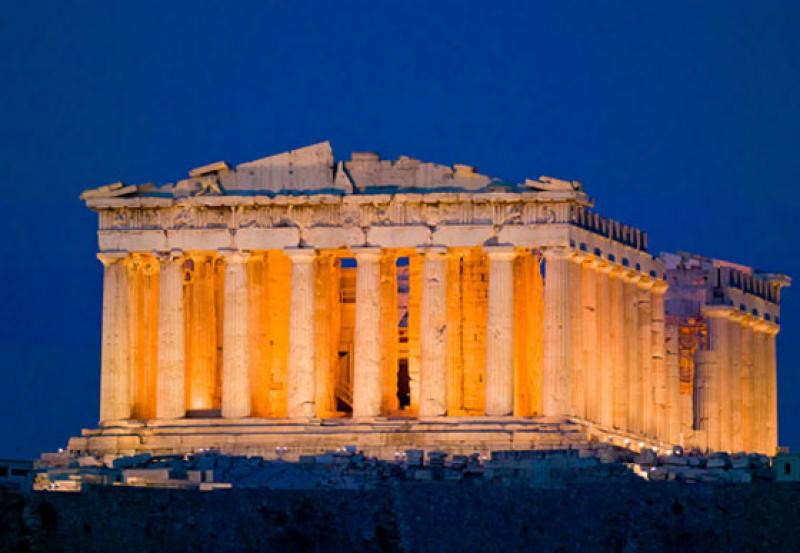
Architecture That Athens Has To Offer
By Ryan Merrifield
Acropolis of Athens
It is not being melodramatic to describe the Acropolis of Athens as the birthplace of civilisation as we know it. This ancient citadel, located on a rocky outcrop towering high over the city of Athens, is an icon of European culture; the architectural remains here hold great significance, not only in terms of archaeology, but also their historical significance for our understanding of science, art, and philosophy today. Although there are other acropolis’s in Greece, the Acropolis of Athens is known as ‘The Acropolis’ across the world, with no need for qualification.
The Acropolis is home to the remains of several significant buildings. Between 447-406 BC, four masterpieces of classical Greek art were constructed; the main temple, the Parthenon; the Propylaea (replacing the Gate of Pisistratus, entrance to the citadel of the ancient kings); the temple of Athena Nike; and the Erechtheion. There are entry fees, but if you’re an EU student, they’re free – so make sure you’ve got your student card on you!
Parthenon
The most magnificent creation of Athenian democracy is the Parthenon, a Doric-style temple dedicated to the goddess Athena (who is considered the patron deity to the people of Athens). Built between 447BC and 438BC, it is regarded as one of the world’s greatest cultural monuments. It was designed by Phidias on behalf of Greek politician Pericles, and would have been home to many treasures, including a gigantic statue of Athena also designed by Phidias, made from gold and elephant ivory(chryselephantine). An Ionic frieze (dated between 442 BC and 438 BC) ran around the exterior walls of the inside structures (cella). It was carved in situ, and depicts the procession of the Panathinaia, from the Dipylon Gate in the Kerameikos to the Acropolis.
Over the years, the Parthenon has changed purpose and usage; in the fifth century AD, it was converted into a church dedicated first to Saint Sophia, and later to the Virgin Mary. Under Turkish rule it became an Islamic mosque. The structure suffered extensive damage in 1687 during the siege of the Acropolis by Morozini – it was used to store gunpowder during this time, and a stray shot caused the powder to explode – today it stands as an archaeological ruin. Work is currently ongoing in a concerted effort by the Greek government, which began in 1975, to restore the Parthenon, as well as other acropolis structures.
Today, nearly all of the original marble frieze sculptures have been removed from the Parthenon. Some of these are located in Athens, in the Acropolis Museum, but there is ongoing controversy over those located in London. Known as the Elgin Marbles, they were removed from the Parthenon by British ambassador Thomas Bruce, 7th Earl of Elgin, to be restored, between 1801 and 1812. They were sold to the British government in 1816 and are today displayed in the British Museum.
Erechtheion
Towards the north side of the acropolis is an elegant temple known as the Erechtheion. It was built to replace an earlier temple dedicated to Athena Polias, and to accommodate the religious rituals which would have taken place there. The west of the Erechtheion was devoted to Poseidon-Erechtheus, and the east end to Athena Polias, protector of the earth and fertility. It housed a wooden statue of Athena, which, despite the massive chryselephantine sculpture found in the Parthenon, still held great religious significance.
The asymmetric design of the Erechtheion stands it in stark contrast to the straight lines and symmetry of the neighbouring Parthenon – there are two main reasons for the uneven structure of this temple. Firstly, it was built over an uneven site with a three metre difference in height between the eastern and western parts of the temple. Additionally, the complex design was required to avoid disturbing the sacred shrines contained there; the marks on the rock where Poseidon was said to have hit Acropolis with his trident; alters to Hephaestus and Poseidon; the sacred olive tree; the tomb of Kekrops.
The exterior of the temple is unusual, with its frieze of white relief figures attached to a dark grey marble background. One of the most recognisable features of the Erechtheion is the six Caryatids, carved female figures serving as columns around the south porch. Those on the acropolis itself are replicas; of the originals, one is today held in the British Museum, and the other five are kept in the museum at the Acropolis. Excavations of the Erechtheion site in 1886 found most of the Kore statues that are now on display in the Acropolis Museum in an open pit at the northwest of the temple.
Temple of Athena Nike
The Temple of Athena Nike is the smallest structure on the Acropolis, situated on the southeast edge. In Mycenaean times, it would have protected the entrance to the citadel. The ceremonial roots on which the temple stands date back to the Bronze Age, although the existing structure was built in 426-421 BC. The eschara, or alter, is said to date back to an earlier temple in around 480 BC, and would have supported the cult statue of Athena Nike, goddess of victory. This statue was wingless, unlike traditional depictions of Nike. This earned the nickname of Apteros Nike (wingless victory), and was said to be so that it could never leave Athens, and therefore could never deprive the city of victory.
Structurally, the temple is built in a simple Ionic style, from Pentelic marble. To the front and back there is a porch with four columns, and all around it is adorned with a sculptural frieze. A later addition to the temple was the inclusion of a parapet, a sort of guardrail which would have stopped people from falling from the top. This was decorated with a frieze, which, rather than depicting a story, showed various presentations of Nike in sculptural relief.
The temple began a new cycle of reconstruction in 1998. The frieze was completely removed and placed in the Acropolis Museum, where it could be protected from further environmental damage. The temple was completely dismantled and the concrete floor, which had been severely corroded, was replaced, as were the iron beams that had been placed there in previous reconstructions.
Propylaea
The Propylaea is the majestic and imposing entrance to the Acropolis, designed by architect Mnesikles. Building began immediately after the completion of the Parthenon in 437 BC, although was halted five years later when the Peloponnesian War broke out. Work was never restarted on the structure; luckily the majority of construction was complete by this time. It was built of white Pentelic marble, with grey Eleusinian marble or limestone for accents.
Entrance to the Acropolis was controlled by the Propylaea; it was important that only the ritually cleansed were allowed access, and that runaway slaves could not enter as once inside, they could claim the protection of the gods. It would have been an imposing gateway, with a wide ramp leading to massive doors flanked by six towering Doric columns. Past the marble steps directly beneath the columns lay a narrower central hall, lined with enormous Ionic columns which supported the weight of the heavy marble slabs that made up the roof. This roof was carved with decorative coffers and painted with vivid ornamental floral and star designs.
The Propylaea is the first monumental building in the classical period to use a structure more complex than a rectangular or cylindrical shape; it has wings to the right and left of the central hall, much smaller in scale but still with Doric columns and styling. Unlike other classical Greek sanctuaries, the Acropolis was built bearing in mind the relation between the buildings there. The Parthenon and the Propylaea are perhaps the most evident of this; both are built in a Doric style, incorporating Ionic columns in their interior. They are also related in size and their locations are oriented similarly.
Share this article:




















